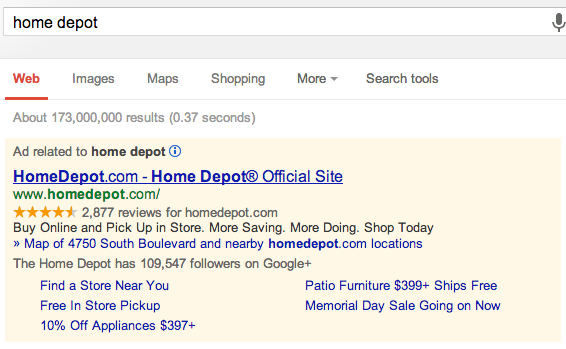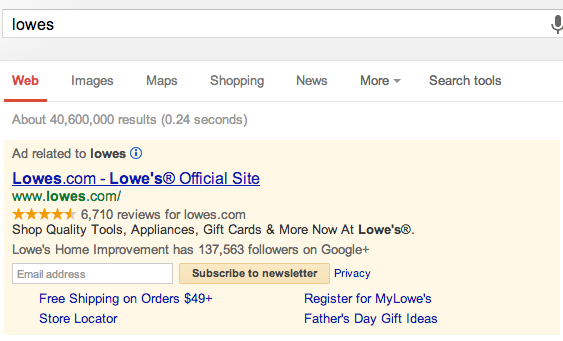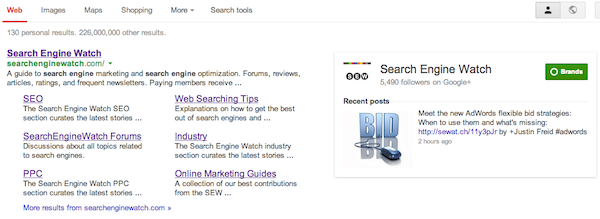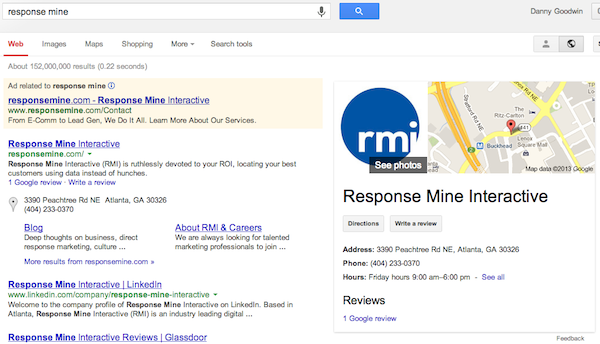For an updated guide on this same subject, check out How to completely dominate the first page of Google, published December 2016.
Your online reputation can impact virtually every aspect of your digital marketing program from the conversion rate on your pages to your click-through rate in paid search. Controlling the conversation around your brand is critical to upholding and improving reputation.
In the long-term, monitoring social activity and proactively combating sources of negative sentiment while engaging the positive is a core strategy.
While long term strategies are great, board members and C-suite executives aren’t known for their patience, especially when it comes to the online perception of their brand.
So what can savvy digital marketers do in the short term? Dominate the entire first page of Google for brand related search queries.
Dominating the first page of Google requires an understanding of the various data types Google displays and how to take advantage. Let’s look at how you can monopolize all brand real estate on the first page of Google.
Paid Search
While it seems obvious to buy your brand terms in paid search to acquire more real estate, many additional tactics exist to maximize this space. The following are ad extensions available in Google that increase the depth of your brand listing:
- Location extensions
- Call extensions
- Offer extensions
- Sitelinks extensions
- Product extensions
- Social extensions
- Dynamic search ad extensions
- App extensions
Keep in mind that you can combine multiple extensions to take up the majority of the premium ad space. Below are two big box home improvement retailers that are capitalizing on some of these extensions. Note how the Home Depot is utilizing sitelinks and how much additional real estate they gain. Also keep in mind that both retailers could be combining more extensions from the above list.


Google+
Brands that have verified Google+ accounts can capture side rail real estate for brand terms by utilizing rel=”publisher”. This works similarly to authorship but is tied to Google+ pages as opposed to individual accounts. The result is a rather large piece of real estate that includes your follower count and a link with image to your latest post.
For more information on how to set up your publisher profile, check out this Google+ starter guide.

Google Images
Optimizing key images on your site such as your logos is another great way to take up potential search engine results page (SERP) real estate. Image search has the potential to drive more incremental visits than you might expect.
In order to optimize your logo for your brand term make sure to include your brand in the image file name, URL where the image is hosted, alt attribute, and title of the image.
YouTube & Other Video
In an effort for Google to continually promote their own properties, videos from YouTube are becoming more prevalent for a variety of different search queries, including brand terms.
Having branded YouTube videos is a great way to own your brand terms. In order to take advantage you need to have at least one video hosted on YouTube. Ideally you have a branded channel, however, this isn’t necessary.
In order to rank higher for your brand, make sure your brand is included in your YouTube username, the name of the video, and in the meta tags of the video. There are many more advanced tactics necessary to rank YouTube videos in Google SERPs, but for brand terms, the above should be enough.
If you want an extra boost, try to solicit comments and votes on you video. Embedding videos on other sites and Google+ 1’s for your video will also help.
Finally, if you have a branded YouTube channel, link to it from your site in the footer.
Google+ Local
Local presents another great opportunity to occupy additional brand real estate. Make sure you have a verified business listing and your feed is optimized.
If you have multiple locations, it’s important to have Google+ location pages link to the corresponding local landing page on your site. This will result in Google merging your SEO landing page and your Google+ local page in the SERPs.
Even if you don’t have multiple locations, you can still take up right rail real estate as seen below.

Google Shopping Ads – PLAs
Product listing ads hit the scene late in Q4 of last year, generating impressive results thus far due to low CPCs and competition.
PLAs are another great way to take up brand real estate for an ecommerce business that sells its own branded merchandise, for example. While this ad type rarely shows in the SERPs for brand terms today, it’s extremely likely that it will in the near future.
News
Regularly syndicating press releases can increase your brand real estate if universal news results are showing. While you can’t directly control if these listings display in the SERPs, having a press release calendar will put you in a position to take advantage if and when they do.
Organic Search
Last but not least is organic search. Obviously you are going to rank for your brand terms, so what can you do in addition?
For your brand domain, head over to Google Webmaster Tools and audit your current site links. While you can’t specify which organic site links will display, you can choose not to serve individual pages.
The most difficult part of owning your brand terms on the first page of Google is getting other domains outside of your official site to rank organically.
The following properties have the highest likelihood of showing up for brand terms: Wikipedia, Twitter, Facebook, YouTube, and LinkedIn. Make sure you have branded accounts and pages on all of these sites.
For the social properties, increased volumes of activity will increase your rankings. Linking from your main site to you social properties with followed links also greatly increases the visibility of these properties on the SERPs.
Finally, any links that you build to these properties will help tremendously. An easy way to accomplish this is through press releases. Add a link to one of your social accounts in the boiler plate of the release. You can also include links from your Wikipedia page to your social profiles.
Conclusion
Owning brand conversation in the digital landscape is critical to converting customers from all marketing channels. Dominating the first page of Google for your brand terms is the first of many steps to achieving this. In recent months, Google has made this task even easier, by reducing the number of organic results for brand terms to only 7.
Taking advantage of the above tactics will help you engage more customers, convert more customers, and build your online reputation.
Editor’s note: This column originally was published on June 3, 2013, and comes in at No. 7 on our countdown of the 10 most read Search Engine Watch columns of 2013. As the clock ticks down to 2014, we’re celebrating the Best of 2013 by revisiting our most popular columns, as determined by our readers. Enjoy and keep checking back!



